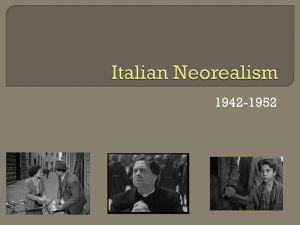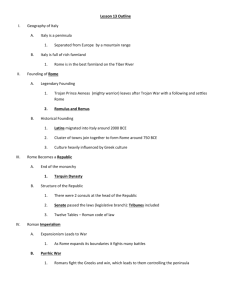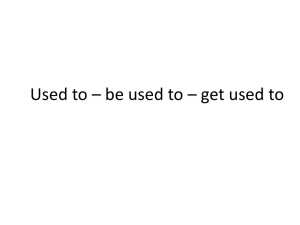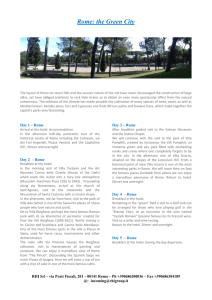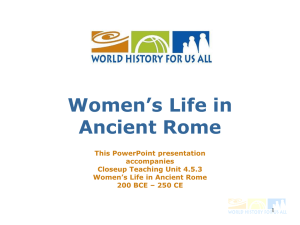Syllabus - Faculty . > Home
advertisement
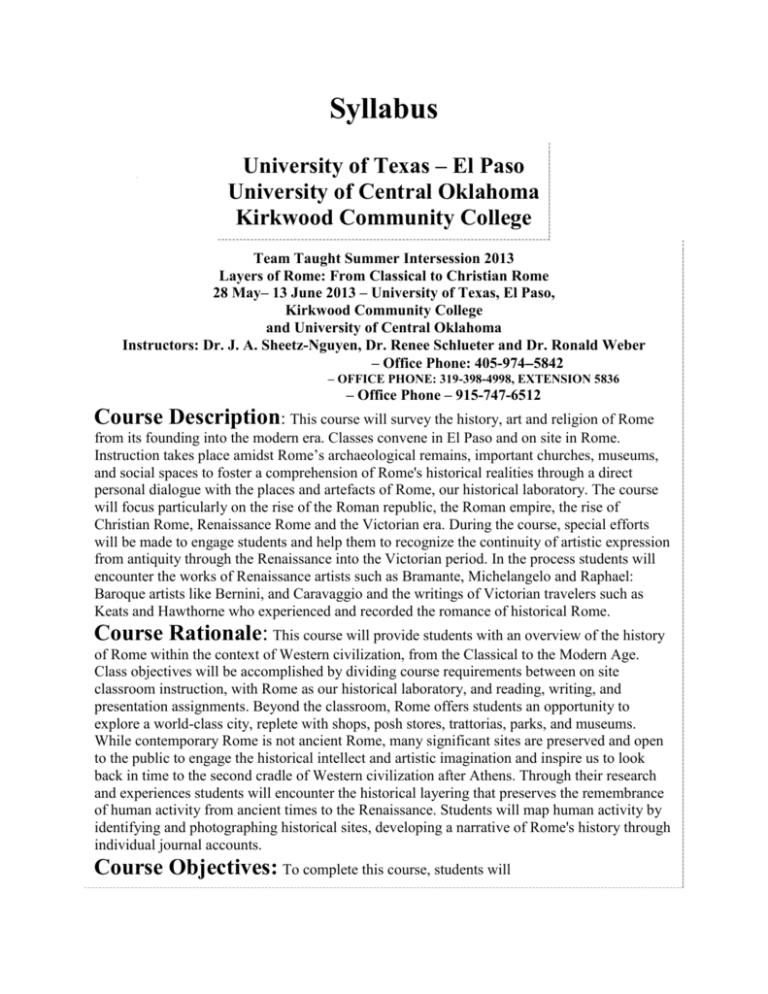
Syllabus University of Texas – El Paso University of Central Oklahoma Kirkwood Community College Team Taught Summer Intersession 2013 Layers of Rome: From Classical to Christian Rome 28 May– 13 June 2013 – University of Texas, El Paso, Kirkwood Community College and University of Central Oklahoma Instructors: Dr. J. A. Sheetz-Nguyen, Dr. Renee Schlueter and Dr. Ronald Weber jsheetznguyen@ucok.edu – Office Phone: 405-9745842 RSCHLUE@KIRKWOOD.EDU – OFFICE PHONE: 319-398-4998, EXTENSION 5836 rweber@utep.edu – Office Phone – 915-747-6512 Course Description: This course will survey the history, art and religion of Rome from its founding into the modern era. Classes convene in El Paso and on site in Rome. Instruction takes place amidst Rome’s archaeological remains, important churches, museums, and social spaces to foster a comprehension of Rome's historical realities through a direct personal dialogue with the places and artefacts of Rome, our historical laboratory. The course will focus particularly on the rise of the Roman republic, the Roman empire, the rise of Christian Rome, Renaissance Rome and the Victorian era. During the course, special efforts will be made to engage students and help them to recognize the continuity of artistic expression from antiquity through the Renaissance into the Victorian period. In the process students will encounter the works of Renaissance artists such as Bramante, Michelangelo and Raphael: Baroque artists like Bernini, and Caravaggio and the writings of Victorian travelers such as Keats and Hawthorne who experienced and recorded the romance of historical Rome. Course Rationale: This course will provide students with an overview of the history of Rome within the context of Western civilization, from the Classical to the Modern Age. Class objectives will be accomplished by dividing course requirements between on site classroom instruction, with Rome as our historical laboratory, and reading, writing, and presentation assignments. Beyond the classroom, Rome offers students an opportunity to explore a world-class city, replete with shops, posh stores, trattorias, parks, and museums. While contemporary Rome is not ancient Rome, many significant sites are preserved and open to the public to engage the historical intellect and artistic imagination and inspire us to look back in time to the second cradle of Western civilization after Athens. Through their research and experiences students will encounter the historical layering that preserves the remembrance of human activity from ancient times to the Renaissance. Students will map human activity by identifying and photographing historical sites, developing a narrative of Rome's history through individual journal accounts. Course Objectives: To complete this course, students will 1 Increase their awareness of the historical and geographical spaces of an ancient city now functioning as a modern European tourist center. 2 Explain the connection between classical, medieval, renaissance and modern Rome. 3 Prepare and present on site in Rome an oral presentation on an historical site, event or person. 4 Research and prepare a brochure to accompany the on-site presentation. a. A printed and revised version of the report must be included in the finished journal. 5 Keep a daily experience journal recording notes from lectures, photographs and personal observations on life in a non-English speaking country. a. Revised and organized journals are due in the professor's office one week after returning to El Paso. 6 Experience the world of travel, crossing international borders, using public transportation and living in a foreign environment. Course Expectations: to complete the course with a high grade students should: 1 Complete all reading and homework assignments. 2 Come to class prepared to participate in all class discussions. 3 Bring a pen, notebook and the assigned reading to every class. 4 Type all assignments in accordance with the MLS style sheet. 5 Know that all assignments are linked to class discussions, readings and videos. 6 Be prepared to present short historical reports on site in Rome. 7 Compile a collection of photos, as part of a journal recording historical discovery and travel experiences. 8 Attend all meetings on site in Rome equipped with pen, paper and textbook. In Rome meetings will be on site from approximately 11:00 am to 3:00 pm. Guidelines for Written and Oral Reports All reports should describe Who, What, When, Where, and Why the subject is important: 1 When written be from 500 to 1000 words in length. 2 When delivered orally be a minimum of five minutes and no more than 6 minutes in length and should engage the whole student body. (Ask the students some questions.) 3 Students should provide a description of their chosen person, event or artifact, including what or who it is; and when and where it became important. 4 Every student at the time of his/her report must provide a brochure to all the members of class summarizing the important elements of the report topic with a list of the sources of the report, (2 books & 1 website) a brief time line, at least one picture and a statement of the significance of the topic in illustrating the class theme. 5 All reports must state why the subject is important for this class. That is how does it address the class theme, “The Layers of Rome.” Guidelines for Journals: all journals must 1 Be typed with pictures and dated 2 MOST IMPORTANTLY: give an account of site visits, side trips, personal encounter. Each site account must answer the question: how did the experience provide deeper understanding of the class theme, "The Layers of Rome"? 3 Include elements of daily life in Rome, both inside and outside of class. a. How did each experience provide deeper understanding of the class theme"The Layers of Rome"? 4 Analyze how class experiences contributed or related to class theme: 5 Include typed, and edited copies of assigned reports. Required Textbooks: Kebric, Robert. Roman People. Mountain View, CA: Mayfield Publishing, 2001. Macadam, Alta. City Guide (Blue Guide) Rome. New York: W.W. Norton, 2000. Partridge, Loren. The Art of Renaissance Rome: 1400-1600. New York: Harry N. Abrams, 1996. Course Reader: An Anthology of Selected Readings (CR) City Map of Rome Recommended: Claridge, Amanda. Rome: Oxford Archaeological Guide. New York: Oxford, 1998. Woodford, Susan. The Art of Greece and Rome. Edinburgh: Cambridge Univ. Pr. 2004 Syllabus Layers of Rome From the Classicalto Christian Worlds Meeting Times in El Paso Dates 4 pm to 8 pm Class Topic In Class Activity Text Assignment May 14 – UTEP Republican Rome Discussion of the Roman Republic Kebric, Robert. Roman People, pp. 1 to 56 Bring printout of syllabus to all classes. May 15 – UTEP Imperial Rome Discussion of the Roman Empire Kebric, Robert. Roman People, pp. 57 to 86 and 122 to 147. May 16 – UTEP Transition to Christian Rome Discussion of the Attraction of Christianity Kebric, Robert. Roman People, pp. 209 to 275. Draft of Report Due May 17 – UTEP Renaissance Rome Chapel Decoration Draft of Brochure Due Founding of Rome the Christian City. Partridge, Loren. The Art of Renaissance Rome, pp.1 to 42. The Great Masters. Michelangelo: matter and spirit Use of art in worship Partridge, Loren. The Art of Renaissance Rome, pp. 43 to 60 and 79 to 108. Partridge, Loren. The Art of Renaissance Rome, pp. 109 to 144. May 18 – UTEP Wrap up Meeting Times and Places in Rome Dates Class Topic Readings and Class Activity 28 May- Monday Departure. Depart El Paso. Arrive in Rome in groups. Transport 29 May- Tuesday. Arrival in arranged from Leonardo da Vinci Aeroporto to Villa Maria. Rome, check in at Villa Maria Introduction to Trastevere and life in Rome by walking tour and recovery. of upper Trastevere neighborhood. Purchase weekly bus tickets for two weeks at cost of approximately 30 euros. Dinner at Villa Maria: KCC/UCO/UTEP Icebreaker Read: T.W. Potter, “Ancient Rome: an introduction,” Blue Guide, 59–67. 30 May - Wednesday. 9:00 a.m. meet in lobby at Villa Class at Crypta Balbi 11:00 am – 1:00 p.m. – directed tour Maria (VM) for first-site departure. Take Bus 44 or 75 to Via Trastevere and transfer to Tram 8 for Largo Argentina. Afternoon walk through Piazza Navona to Pantheon, Victor Emmanuel Monument and Piazza Venezia and worksheet. Antique to the Baroque: Foundations of Medieval Rome: Museo Crypta Balbi, via delle Botteghe Oscure, 31. “Crypta Balbi” http://www.romeguide.it/FILES/visite/crypta_balbi_eng.ht m Bring Sack Lunch – Largo Argentina neighborhood. 2:00 – 5:00 p.m. – visit Piazza Navona, Pantheon, Santa Maria sopra Minerva, and San Ignatio. Piazza Navona – report on three fountains and the Bernini fountain of Four Rivers or Fontana dei Quattro Fiumi. “Piazza Navona,” Blue Guide, 182–86. Visit Pantheon – report on its architecture. Read “The Pantheon,” Blue Guide, 174-78; Read CR: 1. Vitruvius. Ten Books of Architecture “Fundamental Principles”, “On Symmetry: In Temples & the Human Body” Further Reading: Claridge, OAG, Rome; Read Partridge, Art, 118-9. Visit "Santa Maria sopra Minerva" – Christian church built atop Roman temple dedicated to goddess Minerva. Inside, look for the painting in the Carafa Chapel entitled the Assumption of the Virgin, 1488-93 by Filippino Lippi, look for pieces by Michelangelo and Fra Angelico; and notice the ceiling frescoed in gold stars on a blue background. Read-Blue Guide, 178-80 Visit Sant’ Ignazio – find the star and look up to the ceiling. Set your cameras to no flash. Read "Saint Ignazio" Blue Guide, 148. Read - “Vittorio Emmanuele” Blue Guide, 137-38. Recommended dinner spot – Piazza Navona – we know this area is pricey, but look for places with “tourist menus” which include pasta, meat, and vegetable, on south side of Piazza. We usually need to pay for bottled water and bread. If you wish only tap water, request acqua di Roma! Bottled water is mineral water, with salts, and is generally carbonated. If you do not want mineral water, but want bottled water, ask for still water. Going to the Heart of Ancient Rome -the Forum – while visiting these sites, students will offer an overview of the May 31 - Thursday –Bring historical significance of identified sites. Forum bag lunch. When in Rome, do Scavenger Hunt. as the Romans, therefore we While visiting the Forum, Students will be able to visit the are going to have late following sites: lunches. We expect to complete this day about 3:00 1. Altar of the Divine Julius Caesar and Temple of P.M. Castor and Pollux To arrive at the Forum, take Bus 44 to Piazza Venezia. Get 2. House of Vestal Virgins, 3. Arches of Septimius Severus and Titus off bus, cross street towards 4. Basilicas Aemilia and Julia, Constantine and Maxentius Victor Emmanuel 5. Rostra, Column of Phocus and Urbis Umbilicus. Monument; turn right and Afternoon side trip to – Saint Pietro in Vincolo – home to take second long staircase to your left. You will see the Michelangelo’s Moses. twin gods Castor and Pollux greeting you at the top of the Recommended place for dinner – Trastevere – Chinese, Greek, and Il Galleone in Trastevere is great for fish. Il steps. We will meet in the Vascello near Villa Maria is also fantastic for dinner – Campidoglio – the piazza at inexpensive – but plan to spend three hours for dinner the top created by there. There are great take-away pizza places on Via Michelangelo. Carini. A rottiseria near the square offers vegetables and veal, beef, and fried chicken. You can buy and take back to Villa Maria for dinner in on the patio. The Forum Read: T.W. Potter, “Ancient Rome: an introduction,” Blue Guide, 60-69. “The Roman Forum,” Blue Guide, 91–109; and CR Virgil. The Aeneid. Book VI lines 851-947 and lines 1012-1018 June 1, Friday - Colosseum, Arch of Constantine and Palatine Hill Depart VM. on Bus 75. Get off bus after passing the Circus Maximus on your left and walk to the Arch of Constantine. Lived Space of Ancient Rome: from the Colosseum, Arch of Constantine to Palatine Hill – The visit to the Coliseum will provide students with information on the architectural aspects of the exterior and interior of the Coliseum. We will meet at the Arch of Constantine to move into Colosseum and then onto Palatine Hill. While visiting Palatine Hill, students will learn of Caesar Augustus, the Palace of the Emperors, and the Circus Maximus. Rome from a literary perspective will be presented on Palatine Hill overlooking Circus Maximus. Topics are: Hardy, “On Palatine Hill” and “On Building a New Street in the Ancient Quarter” Jessica Wharton, “Roman Fever” – Candace Byron, “Childe Harold’s Pilgrimage,” Recommended sites after the visit to the Colosseum and Palatine Hill is Nero’s Golden House or Saint Peter in Chains, home to Michelangelo’s “Moses.” Hike with Dr. JSN to Baths of Caracalla. Read - Valley of the Colosseum, Blue Guide, 117–32; and “The Palatine Hill, Blue Guide, 103-23. CR: 3. Galerius and Constantine. “Edicts of Toleration” 4. Edith Wharton. “Roman Fever” 5. Thomas Hardy. “On the Palatine” 6. Thomas Hardy. “Building a New Street in the Ancient Quarter” June 2, Saturday – Italian National Holiday Sistine Chapel and Vatican Museums Reports in the Villa Maria Gardens Raphael Raphael Stanze in Vatican Palace Stanza della Signatura Stanza de "elliodoro Salla di Constantino Sistine Chapel – Last Judgment Sistine Chapel – Ceiling Depart VM at 11:00 meet at Vatican Museum Entrance. To get there, walk or take Bus 870 to Piazza delle Rovere and walk across Tiber to Lungo Teverre de Sangallo and turn to right and go to bus stop and take bus 98 to Piazza del Risorgimento. Then walk to Piazza San Pietro. Michelangelo versus Raphael? A Day at the Vatican Museum and the Sistine Chapel. Sistine Chapel – This day we will set out in the early afternoon in order to beat the long lines at the Vatican Museum. Students should be prepared to identify the following large rooms: Gallery of Maps, Gallery of Tapestries, Stanze di Raffaello, including Sala di Constantino, the Loggia of Raphael, Stanza de’Eliodoro, and especially the Stanza della Segnatura (School of Athens and Disputa – Disputation on the Holy Sacrament). In the Sistine Chapel, students should observe the Sibyls, Isaiah, Zacharia, Ezekiel, and Joel. They should outline in their mind the entire Creation panel, and the magnificent Last Judgment. Take note of the Cortile della Pigna, near the Egyptian Museum. You will enter the museum through this open garden. Read “Saint Peter’s at the Vatican,” Blue Guide, 339-56 June 3, Sunday Free Day in Rome June 4, Monday - Read, CR: Pliny the Younger. The Letters LXV “To Tacitus” and LXVI “To Cornelius Tacitus” Optional day in Rome or Pompeii Book tickets to Pompeii in advance June 5, Tuesday Campidoglio, Capitoline Museum. Campidoglio, Capitoline Optional: Corso Walk to Piazza del Popolo, Museum. Caravaggio’s Depart Villa Maria on bus 44 to Conversion of St. Paul Piazza Venizia. Read, Capitoline Museum, Blue Guide, 38 ff and KeatsShelley Memorial, Blue Guide, 173. CR: 7. Tacitus. “Rebuilding the Temple of Jupiter, 70 CE” 8. George Gordon, Lord Byron. Childe Harold, Canto IV excerpt June 6, Wednesday Audience with the Pope and Saint Peter’s Basilica Depart VM at 8:00 A.M. Audience lasts until 12:00 P.M. After the audience meet at Obelisk in Saint Peter’s Square at 1:00 p.m., for Saint Peter’s Basilica visit. Site reports will focus on the message of the Church: Early Christian Basilica, Renaissance rebuilding of Saint Peters’ and interior of the Basilica, including Michelangelo's and Bernini’s designs, the Pieta, sculpture, Baldachinno, Cathedra Petri (Throne of Saint Peter). To get set for the public audience with the Pope on Saint Peter’s Square one needs to leave VM very early. After the audience with the Pope, we will visit to Saint Peter’s Basilica. Walk to Dome is optional – a place that provides one of the most spectacular views of Rome. There are certain features of the basilica that should draw your attention. Instructors will ask you to identify. Porta Santa Michelangelo’s Pieta Bronze statue of Cathedra of the Saint Peter Saint Peter Baldachinno Michelangelo’s Saint Dome Helena Bernini’s Dove Bernini's Bees Read: “Saint Peter’s at the Vatican,” Blue Guide, 339-56 Recommended site visit after the Vatican – Castel Sant' Angelo June 7, Thursday - Villa Borghese, Palazzo Barberini, Optional: Bernini Walk Admission to the Borghese is From Satyrs to Unicorns or from Hadrian to Cardinal Scippione Borghese: the Villa Borghese Visit to Villa Borghese, an important palace open to the public with an art collection that includes Raphael, only by appointment; therefore, departure time will depend upon admission time. It is most efficient to take Bus 75 to Termini Station. Transfer to Bus 910 to Via Pinciana (6 stops). Bernini, and Caravaggio. Pay attention to statues from antiquity in large reception room as you enter Villa. Note Roman mosaics of gladiators on floor. Bernini may steal the show here in his beautiful sculpted pieces, Truth, David, and Apollo and Daphne. There are more – be on the look-out. Caravaggio also has a special showing here, including his Boy Crowned with Ivy, and David with head of Goliath. Make sure you identify Raphael’s portrait of his patron, Julius II. Site reports will be presented in gardens in front of Villa Borghese: Read: Santa Maria del Popolo and Spagna, Blue Guide, 150-6; “From the fall of the Roman Empire to the present,” Blue Guide, 68–71; Renaissance to Twentieth Century Rome, Blue Guide, 71–3. CR: 18. Pico della Mirandola. From “Oration on the Dignity of Man” 19. Baldassare Castiglione. The Book of the Courtier. From Book I—on the “gentleman”; from Book III on the “lady” June 8, Friday – Keats-Shelley House, and Protestant Cemetery. Depart VM on Bus 75 to Termini Station and transfer to Metro to Spanish Steps. Age of Romanticism, Era of Nationalism---Keats-Shelley House Lunch Lunch near Protestant Cemetery (graves of Keats, Shelley, Julius August Gramsci and others) Read: CR: 13. John Keats. “Ode on a Grecian Urn” and “To Charles Brown” 14. Percy Bysshe Shelley. From “Adonais” 15. Thomas Hardy. “At the Pyramid of Cestius Near the Graves of Shelley and Keats” 16. Robert Browning. “The Bishop Orders his Tomb at St. Praxed’s” 17. Johann Wolfgang von Goethe. Selected letters from Italy, written in 1786. June 9 – Saturday - Layered Rome, Ostia Antica. Optional: Lido Beach Depart VM. on Bus 75 to Pyramide June 10, Sunday – Day Off June 11, Monday – Day Off Read: “Ostia Antica,” Blue Guide, 447-61 June 12, Tuesday Return to El Paso
